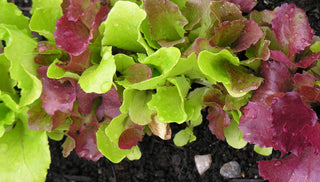There are hundreds of kinds of leaf lettuce in colors ranging from lime green to dark green and bright red to dark purple. These various lettuces can be grown in two ways. For a mix of tender young leaves, sow the seeds relatively thickly (about an inch apart) and harvest the leaves with a scissors when they're the size you like. Cut to just about an inch above soil level. The plants will grow back quickly and you can expect to get at least three or four more crops of young leaves.
Leaf lettuce may also be grown at a lower density, allowing more space between the plants. The plants will get larger and the leaves will get bigger. Plants may be cut to the ground as above, or you can just remove the largest leaves as you need them. When thinning out a planting of lettuce, you can move some of the plants around the garden, filling in any empty spots. Done at dusk or on a rainy day, these small transplants will take quickly to a new location.

Lettuce is generally considered a cool-weather crop, but varieties will do quite well in the heat of summer. Look for types that are especially tolerant of warm weather. In midsummer, lettuce may be grown in the shade of tomatoes or pole beans. You can also grow it under a section of shade cloth, stretched over support hoops.
The key to having a good supply of high-quality lettuce, is to plant a few seeds every two or three weeks during the growing season. Keep your eyes open for any vacant spots in the garden and when you find one, tuck in a few lettuce seeds. Once a lettuce plant goes past its prime, the sap becomes milky, the leaves get bitter and the center of the plant will elongate into a seed stalk. Don't let these over-mature plants take up space in your garden. Pull them out quickly and replant the area with new lettuce seed or a fall crop of beets or carrots.
Lettuce can be started indoors under lights (where it's easy to monitor growth), or you can plant seeds directly in the garden. Sprinkle the seeds as sparsely as possible over the prepared area and press them down gently with the palm of your hand. Cover with a very fine layer of soil as light is required for good germination.
Many seed companies now sell seed mixes that contain half a dozen or more different varieties of lettuce. These mixes make colorful, flavorful salads. It's also a fun way to learn which types of lettuce you like best, and also experiment with some more unusual salad greens such as arugula, mustard and mesclun.





